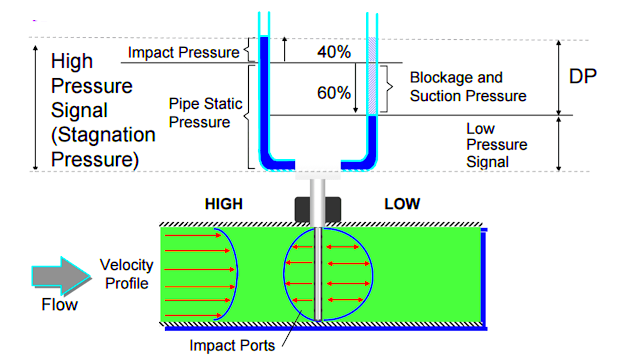Annubar flow meter advantages and disadvantages
Annubar flow meter
An annubar is very similar to a pitot tube. The difference is that there is more than one hole into the pressure measuring chambers. The pressure in the high-pressure chamber represents an average of the velocity across the pipe. Annubars are more accurate than pitots as they are not as position sensitive or as sensitive to the velocity profile of the fluid.There may be a single port or multiple tapping ports on the opposite side of the bar to measure the low static pressure in the downstream region. The difference between the total and static pressures is effectively a measure of the fluid velocity head, which together with the pipe area enables the volumetric flowrate to be determined.
Annubar flow meter Principle
The Annubar primary flow element is a device used to measure the flow of a liquid, gas or steam fluid that flows through a pipe. It enables flow measurement by creating a differential pressure (DP) that is proportional to the square of the velocity of the fluid in the pipe, in accordance with Bernoulli’s theorem. This DP is measured and converted into a flow rate using a secondary device, such as a DP pressure transmitter. The flow is related to DP through the following relationship.Q = Flow Rate
K = Annubar Flow Coefficient
DP = Differential Pressure
The Annubar generates a DP by creating blockage in the pipe and acting as an obstruction to the fluid. The velocity of the fluid is decreased and stalled as it reaches the front surface the Annubar sensor, creating the impact/high pressure. The Annubar senses the impact pressure by utilizing a DP transmitter.
As the fluid continues around the Annubar sensor, it creates a lower velocity profile on the backside of the sensor, creating the low/suction pressure downstream of the Annubar. Individual ports, located on the backside of the Annubar sensor measure this low pressure. Working on the same principle as the high pressure, an average low pressure is maintained in the low pressure chamber that connects directly into the transmitter for measurement. The resultant differential pressure is the difference between the impact (high) pressure reading and the suction (low) pressure reading as seen below.
DP = High Pressure(PH) – Low Pressure(PL)
The measured DP is used to calculate the flow rate.
Advantages
- Can be inserted through a small opening.
- Can be used to sample the velocity at several points.
- Low pressure drop, minimal obstruction.
Disadvantages
- Single point measurement.
- Pitot tube is fragile
- DP signal is low.




Comments
Post a Comment